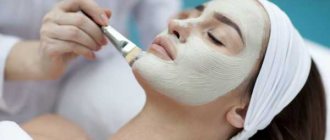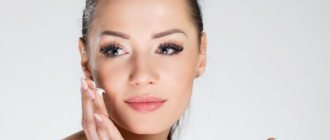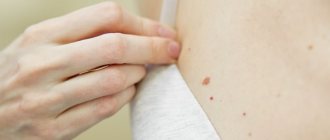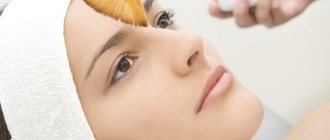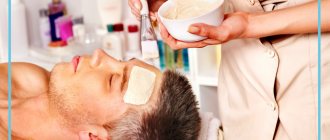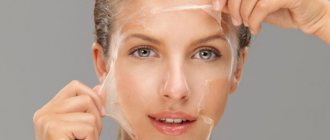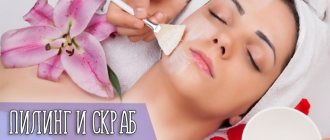In recent years, such an industry as hardware cosmetology has been widely developing; procedures in this case are carried out using special devices - both in medical institutions and independently, at home. And if in a health center you can rely on the competence of a specialist (cosmetologist, physiotherapist), then at home you can only count on your own literacy. What should an expectant mother know when visiting a cosmetologist or planning to purchase a device for home use?
What mechanical cosmetic procedures are safe to do during pregnancy?
Among the methods of exposure to mechanical cosmetic devices, brossage . This is the removal of dead skin flakes from its surface using brushes rotating at a given speed. This procedure can be carried out regularly (once every 1-2 weeks) for both facial skin and body. This method of cleansing is quite acceptable during pregnancy, but is not suitable for those with sensitive skin and nearby blood vessels. It is important to remember that the procedure should not cause discomfort or unpleasant sensations: such effects are nothing more than an incorrectly chosen speed of the procedure, as well as the degree of pressure on the skin. Such devices are rarely sold for home care. But, taking a regular round soft brush for cleansing the face (or a harder one for the body), you can make circular massage movements over the entire surface of the skin. In fact, this will only be a more gentle method of casting. Do not forget that brossage is a technique of exfoliation, not cleansing of the skin. Use the brush only after thoroughly removing makeup and impurities from the skin.
Pressotherapy. This procedure is most widespread in body care. Its action is based on a mechanical effect (pulsating pressure of compressed air) on the body or its individual parts (usually legs and arms). Pressotherapy of the whole body during pregnancy is contraindicated (squeezing the abdominal area is undesirable), but it will be very useful for the arms and legs. Uniform pulsating pressure allows you to reduce the lumen of the veins, increase venous and lymphatic outflow from small vessels to the center. Before the procedure, “boots” and “sleeves” made of dense fabric, vaguely reminiscent of an astronaut’s spacesuit, are put on the limbs. When the device is turned on, compressed air is pumped into the space between the inner and outer layers, exerting pressure on the limbs and, as a result, having a lymphatic drainage effect.
Subsequent relaxation of the cuff ensures an active flow of arterial blood to the tissues, which improves blood circulation and metabolism in the muscles, skin and subcutaneous tissue. This procedure can be obtained not only in a salon or wellness center - local pressotherapy is currently also represented by devices for home use.
List of approved DermaQuest peels
Milk peeling for delicate skin
Milk peeling with Hyaluronic acid is a professional enriched all-season peeling with moisturizing, restoring and healing effects. Restores skin barriers, works against glycation.
Ideal against dryness, tightness, discomfort, prevents pigmentation against irritated skin.
- Moisturizes the skin - lactic acid is part of NMF (skin moisturizing factor), restores the skin barrier function. Micronized hyaluronic acid – active hydration inside the skin.
- Lightens the skin , evens out tone and improves complexion.
- Eliminates dryness and tightness of the skin - removes hyperkeratosis and flaking.
- Smoothes superficial wrinkles and dry lines.
Immediately after the procedure, the skin takes on a fresh, healthy look, and the tone and complexion are evened out!
Peeling contains:
- Lactic acid 30% - gentle exfoliation of the skin, restoration of skin barriers;
- Phytic acid 5% – soft keratolytic + whitening;
- Micronized hyaluronic acid – moisturizes and restores the skin;
- Red Grape Stem Cells – prevents all manifestations of photoaging;
- ALISTIN (carnosine) – against skin glycation.
A video with the stages of peeling and the results is here .
Peeling MangoBright
Peeling MangoBright is a professional enriched all-season peeling for age spots. Ideally works against age spots, acne, dry skin, dehydration and hyperkeratosis. Evens out skin tone and gives a fresh, rested look.
Peeling contains:
- Lactic acid 30% - in this concentration equally performs a delicate exfoliating effect (eliminates hyperkeratosis) and moisturizing, promoting the penetration of active ingredients from mango pulp;
- Phytic acid 5% is a mild keratolytic and powerful antioxidant, has an anti-tyrosinase effect (lightens the skin);
- Kojic acid 5% - also works to lighten the skin (tyrosinase blocker), has an antioxidant effect;
- The peeling contains Sweet Orange Stem Cells , which stimulate the synthetic activity of fibroblasts and have an antioxidant effect;
- Micronized hyaluronic acid – moisturizing and restoring the hydrolipid mantle of the skin;
Peeling is indicated for the correction of diffuse pigmentation of any origin, including after hyperinsolation;
Works against all symptoms of photoaging , lightens pigmentation, moisturizes and restores skin barriers, saturates the skin with antioxidants;
Recommended for glycolic acid intolerance and skin hypersensitivity.
A video with the stages of peeling and the results is here.
Is it possible to do thermal procedures during pregnancy?
Among thermal methods, a distinction is made between the effects of low temperatures (cryotherapy) and high temperatures (baths, saunas, infrared heaters).
Of the cryotherapy during pregnancy, only cryomassage of the face is permissible - exposure of the skin to liquid nitrogen vapor. Cold provides a sharp constriction of blood vessels (calming effect). At the end of the procedure, the vessels dilate, blood circulation is activated, and skin tissue nutrition improves.
Exposure to high temperatures during pregnancy is strictly limited (as high temperatures pose a risk of miscarriage). Therefore, procedures such as an infrared sauna should be used no earlier than the second trimester of pregnancy, in a very dosed mode (no more than 5-10 minutes, at a temperature of about 40°C).
Light therapy during pregnancy
Exposure to light, as well as various options for color exposure - chromotherapy or color therapy - have become widespread in recent years. Exposure to light (ultraviolet and infrared waves are excluded from the spectrum) normalizes neuroendocrine regulation of the entire body, strengthens the immune system, and stimulates the healing process. Both light and color therapy can be used during pregnancy. Devices for light and color therapy also exist in a portable version for home use.
Ultrasound cosmetology for pregnant women
Ultrasound (US) waves are widely used in cosmetology. When in contact with the skin (through a moisture-containing medium), ultrasound provides micromassage with improved blood and lymph circulation, as well as thermal effects, which provides increased nutrition to skin tissue and stimulation of tissue metabolism. As a rule, ultrasound is used in three main ways: ultrasound peeling, massage and phonophoresis (that is, the introduction of medicinal/cosmetic preparations). All of them feel comfortable and give noticeable results even after one procedure.
Ultrasound devices can also be found in portable form for home use. If you decide to use such a device, carefully read the instructions and find out which cosmetic products can be combined with the procedure. For phonophoresis, products with a gel texture are usually used. Ultrasonic peeling can also be used with ordinary distilled water. It is important to remember that contraindications to the U3 procedure are an excessively expanded capillary network, severe chronic diseases, and infections in the acute stage (for example, herpes). When applied to the body, ultrasound not only improves blood flow, but also has a defibrosing effect, helps soften and destroy fibrous (connective tissue) partitions, which are responsible for the appearance of the “orange peel”. Such partitions appear as a result of circulatory disorders and hypoxia (oxygen starvation) of tissues. The destruction of these partitions is necessary in the treatment of cellulite. However, this procedure is best left until the postpartum period.
Keep it in moderation! Manufacturers of devices for home use have made them less powerful than professional ones, observing the main rule of medicine - “do no harm.” It is important to carefully follow the instructions. Attempts to increase the effect by lengthening the procedure time (sometimes 2-3 times longer than the time indicated in the annotation) can lead to a diametrically opposite result.
What salon procedures are contraindicated for pregnant women?
Electric currents (alternating, direct, different voltages, frequencies and other physical characteristics) are very widespread in cosmetology. Perhaps there is no such aesthetic problem in the solution of which currents do not participate. The reason lies in the fact that every cell of a living organism also has electrical potential. Its pathological change, requiring correction, or stimulation during slowly ongoing processes - all this can be done by currents. However, their effects are contraindicated when carrying a child (due to the possible threat of miscarriage). To know which procedures you should avoid for now, we list the main ones:
- Galvanization is the action of direct current of low strength and low voltage. Its action activates the membrane of skin cells, changes the flow of charged molecules into and out of the cell, and activates blood circulation and metabolism. Therefore, the effect of the procedure will be to improve tissue nutrition and enhance metabolism. Galvanization includes electrophoresis, that is, the introduction of charged drugs and cosmetics into the skin under the influence of current. A special case of galvanization is disincrustation. In this case, electrophoresis is used, which involves cosmetics with an alkaline component. They come into contact with the secretion of the sebaceous glands, thereby deeply cleansing the pores. This procedure is of greatest interest in caring for oily skin.
- Darsonvalization is the use of alternating currents of low strength but high frequency. The principle of operation of the current is as follows: it is supplied to a glass flask, causing ionization of the air, as a result of which a low-power electric discharge is created. The effect of such charges on the skin improves blood microcirculation, reduces venous stagnation, eliminates swelling and resolves inflammatory processes. The device for this procedure is perhaps the most common among “home” cosmetology equipment. Most often it is used to treat oily problem skin or to prevent hair loss.
- Microcurrent therapy is the use of ultra-low amplitude pulsed current. Causes activation of metabolism at the level of living skin cells. Stimulation of cell function, in turn, leads to activation of metabolism throughout the entire thickness of the skin and activation of blood circulation.
- Myostimulation is the action of mid-frequency pulse current. This type of current has a deeper penetrating ability, and therefore is able to affect muscles. Electrical stimulation causes the muscles to contract, often referred to as a "lazy person's workout." This procedure is recommended as an alternative to massage for age-related changes (decrease in muscle tone) of the skin of the face and body. After childbirth, such a procedure will help restore the tone of the abdominal muscles, but during pregnancy it is strictly contraindicated due to the fact that it may threaten its interruption. It is important to remember about other contraindications to the use of procedures with currents: the presence of large metal structures in the body, for example, pins in the bones (metal-ceramic teeth do not apply here), as well as gold threads (they are located very close to the surface of the skin), an artificial pacemaker in the heart . Electric current is also used in hair removal procedures, that is, electrolysis. Like all other current procedures, it should be postponed until after the baby is born.
Neuromodulators
Botulinum toxin type A has both cosmetic and medical indications (Tan et al., 2013)
.
Recent evidence suggests, but does not fully confirm, that the toxin does not reach significant concentrations in the body if administered intramuscularly or intradermally. In addition, the size of the toxin molecule makes it unlikely to cross the placental barrier (Tan et al., 2013)
.
There are no clinical studies of the effects of botulinum toxin on pregnant women. However, there are a number of case reports where the toxin has been used for various medical procedures in pregnant patients without adverse fetal outcomes. Two recent studies have demonstrated the safety of botulinum toxin A for the treatment of achalasia in pregnant women. Hooft et al. (2015) reported the administration of an intrasynthetic injection of botulinum toxin A at 14 weeks of gestation without adverse effects on the fetus. Wataganara et al. (2009) reported a similar case where botulinum toxin A was administered at 33 weeks of gestation to treat persistent achalasia. No adverse fetal outcomes were noted and no evidence of infantile neuromuscular blockade was noted 5 days postpartum (Wataganara et al., 2009)
.
Most likely, I don’t use BTA; these may be random variations, although some types of BTA have now received approval for use during pregnancy. Sokolova Elena Viktorovna
Botulinum toxin A has been used safely in pregnant patients, as demonstrated by numerous reports and case series.
Robinson and Grogan (2014)
reported the safe administration of botulinum toxin A during 18 weeks of pregnancy for the treatment of migraine in a woman with refractory migraine.
Bodkin et al (2005) reported two cases of accidental administration of botulinum toxin A during the first trimester of pregnancy in patients being treated for cervical dystonia. One patient with a history of miscarriages miscarried at 10 weeks and was experiencing a twin pregnancy at this time (Bodkin et al., 2005).
.
Newman et al. (2004) reported the case of a woman with severe cervical dystonia who was treated with botulinum toxin injection during four consecutive pregnancies. No complications were reported (Newman et al., 2004)
.
Two cases of cosmetic use of botulinum toxin were reported by Oliveira Monteiro (2006) in two women at 6 and 5 weeks of gestation without adverse effects on the fetus.
A 2006 survey of 900 physicians by Morgan et al. (2006) found that 12 physicians had experience inadvertently injecting botulinum toxin into 16 pregnant patients. Only one patient with a history of spontaneous abortion had a miscarriage after botulinum toxin injection (Morgan et al., 2006)
.
There is concern that high doses (>600 U) of botulinum toxin are associated with systemic weakness (Lee et al., 2013)
. However, doses used in cosmetic procedures are typically less than 100 units.
Although the above cases demonstrate the general safety of botulinum toxin A, there is still insufficient data to make specific recommendations regarding whether botulinum toxin correction procedures should be performed in pregnant women.
Vacuum massage for pregnant women
The effect of vacuum, that is, negative pressure created in an airless environment, is as follows: the pressure “sucks” dead skin cells to itself, opens pores, increases blood circulation, and extracts secretions from the sebaceous glands. vacuum facial cleansing procedure is based on this principle . This option of hygienic cleaning is considered gentle, atraumatic and is recommended in all cases, except for pronounced vascular network on the face and exacerbations of dermatological diseases.
Vacuum is also used for massage , since its surge movements (based on the principle of a pump) activate the flow of lymph and blood and normalize muscle tone. Vacuum massage is used both in facial care and in procedures that model the silhouette. The method has many advantages, including safety; it is acceptable in almost all situations where exposure to electric currents is contraindicated. That is why vacuum devices are widely represented among household appliances. Even before the advent of modern devices, vacuum massage was carried out using cups. Initially, glass jars were used, the inner surface of which was heated using a probe with burning cotton wool. Now glass jars have been replaced by plastic ones, which are safer and easier to work with. The jar is sucked to the skin due to the action of rarefied air, after which it slowly moves over the skin lubricated with oil or cream. Under the influence of rarefied air, blood circulation is significantly enhanced and long-term tissue heating is achieved. This method is also used for figure correction. However, vacuum therapy also has its contraindications: vascular weakness (tendency to bleeding and bruising), blood diseases.
Indications for use
Ultrasonic facial cleansing is an effective procedure that becomes a salvation for many girls. It is great for both regular care and for solving delicate skin problems.
In the list of indications:
- Oily shine.
- Formation of blackheads (comedones).
- Severe swelling.
- Dull, gray complexion.
- Acne, inflammatory elements.
- Hyperkeratosis (increased peeling).
- Post-acne.
- Age-related ptosis.
Is vibration massage possible for pregnant women?
Vibration is periodic mechanical vibrations perceived by the body. This effect on the body has an analgesic effect, has a calming effect, and normalizes blood circulation. Vibromassage is usually used in body care procedures, most often in combination with other influences. But mechanical shocks during pregnancy are undesirable, because... they raise the risk of its interruption. Therefore, the expectant mother should also refrain from this procedure.
Fillers
21 fillers have been approved by the US Food and Drug Administration, including collagen, hyaluronic acid, roxyl apatite and poly-L-lactic acid (Chacon, 2015)
.
No safety data have been reported for the use of cosmetic fillers during pregnancy. Adverse events associated with use include most commonly local reactions and rarely granulomas, vascular response, hypersensitivity reactions and cellulitis (Lolis et al., 2015)
.
Due to the lack of evidence of safety in pregnant patients, recommendations for the use of fillers cannot be definitive.
The physician should be aware of the potential risks of inadvertent arterial injection of lidocaine mixed with filler.
Other methods
Modern methods of cosmetic treatment, photo and laser methods of rejuvenation and hair removal should also be postponed until the postpartum period. These methods have appeared relatively recently, their long-term effect has been little studied, so for the maximum safety of your baby, wait until he is born.
To summarize, I would like to say that hardware cosmetology occupies a significant place among procedures for maintaining beauty and health. Knowledge of the operating principles of the devices, indications and contraindications, effects and side effects will allow you to achieve noticeable results in skin care. At the same time, the irrational use of certain methods can adversely affect the condition of not only the skin, but also the entire body. So, when considering a proposed procedure or device, remember what is behind the beautiful name and fashionable design.
